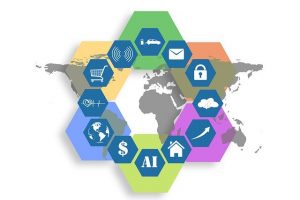
What Is Artificial Intelligence And Machine Learning?
Artificial intelligence (AI) offers the possibility of direct interaction between people and machines. When machines become intelligent, they can understand requests, connect bits of data, and draw conclusions. They can plan, observe, and think. Consider:
- Do you have a vacation planned for tomorrow? Automatic weather and travel notifications for your chosen city will be sent to your smart device.
- Do you have elaborate birthday plans? You can rely on your clever bot to help with invitations, bookings, and cake pick-up reminders.
- Do you have a direct marketing campaign in the works? Your AI assistant can naturally categorise your customers so that you may send them customised messages and obtain better response rates.
No, we’re not referring to robot butlers. Not a Hollywood production, this. However, in artificial intelligence, we have advanced to a new level of cognition that has shown to be helpful in our daily lives. But we comprehend. The relationships between AI, machine learning, and deep learning baffle you. You don’t exist alone. And we want to help.
We’ll examine the fundamentals of artificial intelligence in this piece and how various technologies have combined to make machines more intelligent.
What is Artificial Intelligence (AI)?
Artificial intelligence refers to a computer system’s ability to simulate human cognitive powers such as learning and problem-solving. A computer system that employs AI incorporates arithmetic and logic to imitate humans’ reasoning to learn from new information and make decisions.
What is Machine Learning (ML)?
Machine learning is an application of AI. It is the technique of utilising mathematical data models to assist a computer in learning without direct instruction. This allows a computer system to learn and improve independently, depending on experience.
What is the connection between AI and ML?
Although they are closely connected, artificial intelligence and machine learning are different. Artificial intelligence is said to include machine learning. Intelligent computers utilise AI to mimic human thought and carry out tasks independently. The method through which a computer system develops intelligence is called machine learning.
One way to teach a computer to mimic human reasoning is to use a neural network, a collection of algorithms motivated by the human brain. The neural network helps the computer system implement deep learning for AI. Because of their close connection, the argument between artificial intelligence and machine learning mainly concerns their interactions.
History of AI and ML
So, where did AI come from? However, it didn’t go from one-player chess games to self-driving cars. The field has a rich history that includes contributions from military science, statistics, mathematics, philosophy, psychology, and cognitive science. Artificial intelligence’s purpose was to increase computers’ practicality and reasoning power.
Most historians attribute the invention of artificial intelligence to a 1956 Dartmouth research effort that looked into topics including problem-solving and extended techniques.
For instance, the Defence Advanced Research Programs Agency (DARPA) worked on street mapping programmes in the 1970s. And in 2003, DARPA created intelligent personal assistants, years before Microsoft, Amazon, or Google launched programmes of a similar nature. This research laid the foundation for formal reasoning and automation in modern computers.
Benefits of AI and ML
Businesses may gain significantly from the interaction between artificial intelligence and machine learning in almost every industry, and new opportunities are constantly opening up. Here are just a few of the numerous benefits that companies have already discovered:
1. Additional sources of data entry
Businesses can extract valuable insights from various structured and unstructured data sources using AI and machine learning.
2. Increased operating efficiency
Through process automation using AI and machine learning, businesses become more efficient, lowering costs and releasing time and resources for other priorities.
3. Enhanced decision making
Faster and better decision-making Businesses use AI and machine learning to reduce human error and boost data quality, resulting in better data-driven decisions.
Applications of AI and ML
To succeed in nearly any industry, organisations must be able to transform data into actionable knowledge. Artificial intelligence and machine learning help businesses by automating various human processes involving data and decision-making.
By combining AI and machine learning into their strategies and strategic plans, leaders can interpret and take action on data-driven insights more rapidly and effectively.
1. AI and ML in the Manufacturing Sector
For a manufacturing company to be successful, efficiency is essential. Artificial intelligence may help corporate leaders automate their procedures by utilising data analytics and machine learning in the following applications:
- Utilising machine learning, analytics, and the internet of things (IoT) to find equipment flaws before they lead to problems.
- Utilising a plant-installed device with an AI application that monitors production equipment and projects when maintenance should be done to prevent failure amid a shift.
- Analysing trends in HVAC energy use and using machine learning to maximise comfort and energy savings.
2. AI and ML in banking
Security and privacy of data are crucial in the banking industry. Financial services leaders may increase efficiency in a variety of ways by utilising AI and machine learning to protect client data:
- Cybersecurity breaches and fraud are being detected and prevented with the help of machine learning.
- To manage documents and quickly verify user identities, biometrics and computer vision are being deployed.
- Basic customer service tasks are automated using intelligent technology like chatbots and voice assistants.
3. AI and ML in healthcare
The health care business generates enormous amounts of data and increasingly relies on informatics and analytics to provide trustworthy and efficient health services. AI tools can help doctors deliver better care, save time, and potentially prevent burnout.
- Users’ electronic health records are analysed using machine learning to provide automated insights and clinical decision support.
- Incorporating an AI system that forecasts hospital visits results to lower readmissions and cuts down on patient stays.
- Providers-patient conversations are captured and recorded using natural language understanding during exams or telemedicine sessions.
Final words
You may ask a computer questions about sales, inventory, customer retention, fraud detection, and many other topics using artificial intelligence (AI). Additionally, a machine can provide solutions to queries you never even considered posing. It will give a narrative summary of your findings and ideas for more research. Additionally, it will provide details on earlier inquiries that you or others have made comparable to yours. You can learn the answers through speech or on a screen.
What will happen in actual practice? In the medical field, treatment effectiveness may be established more quickly. In retail, other products might be recommended more quickly. Fraud in the financial sector can be avoided rather than detected. And a whole lot more.
In each of these situations, the computer recognises the necessary information, looks at the relationships between all the variables, formulates an answer, and then automatically displays it to you, along with options for more questions.



